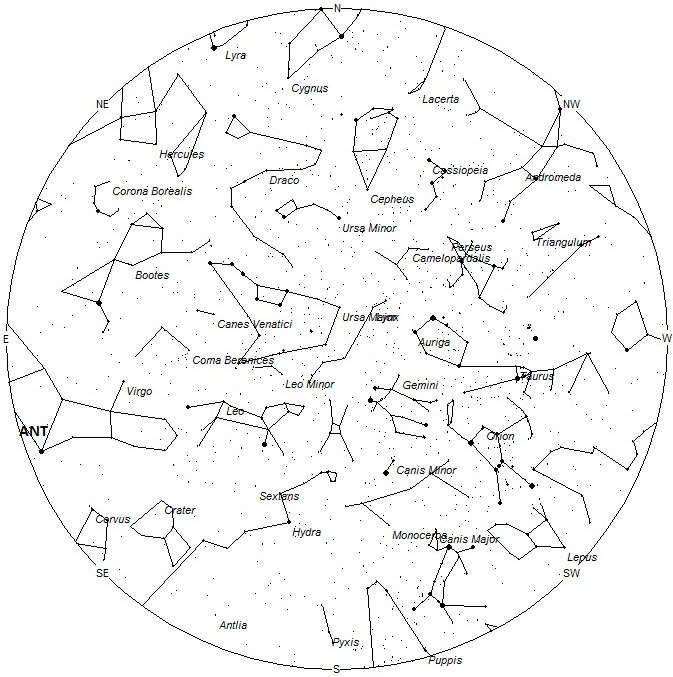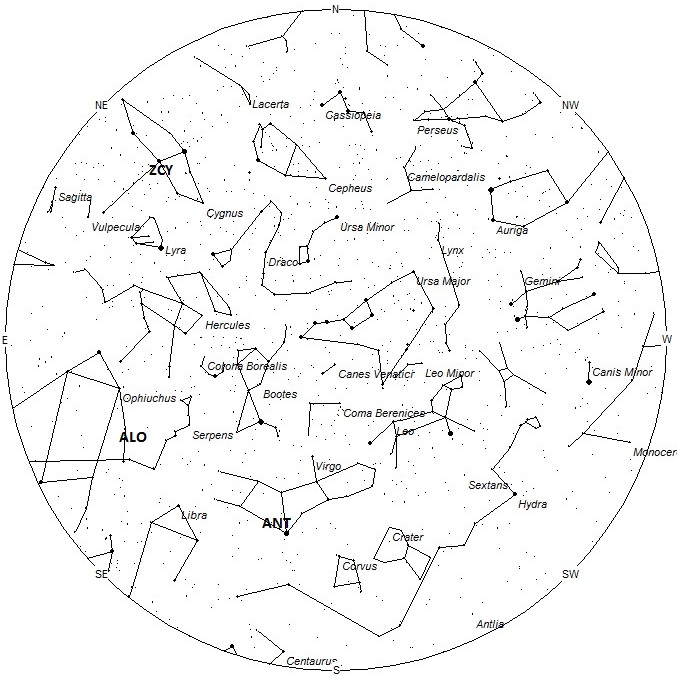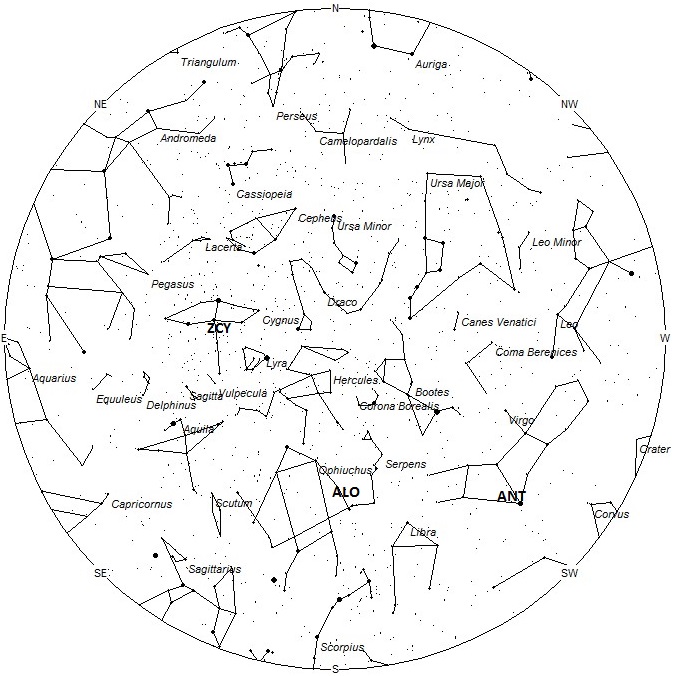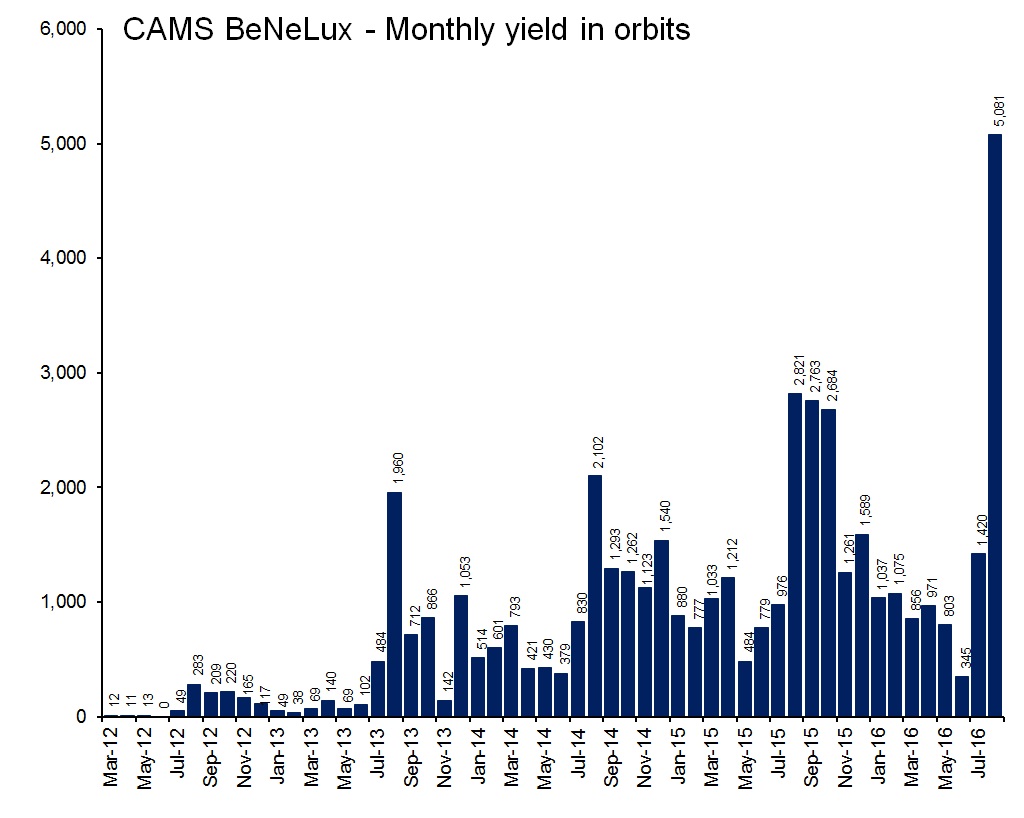Meteor activity picks up a bit during April as the Lyrids become active during the month. They are active from the 14th through the 30th, with a pronounced maximum on the 23rd. Sporadic rates during April are steady as seen from both hemispheres with southern observers enjoying more activity that can be seen from the mid-northern hemisphere. The eta Aquariids will become active the second half of the month, adding a few swift meteors to the late morning scene.
During this period the moon will reach its new phase on Friday April 5th. This weekend and for most of the week, the waning crescent moon will rise during the early morning hours but will not interfere with meteor observing as long as you keep the moon out of your field of view. Hourly meteor rates for evening observers this week is near 3 as seen from mid-northern latitudes (45N) and 4 as seen from tropical southern locations (25S). For morning observers the estimated total hourly rates should be near 8 as seen from mid-northern latitudes and 10 from the southern tropics. The actual rates will also depend on factors such as personal light and motion perception, local weather conditions, alertness and experience in watching meteor activity. Morning rates are slightly reduced during this period due to moonlight. Note that the hourly rates listed below are estimates as viewed from dark sky sites away from urban light sources. Observers viewing from urban areas will see less activity as only the brighter meteors will be visible from such locations.
The radiant (the area of the sky where meteors appear to shoot from) positions and rates listed below are exact for Saturday night/Sunday morning March 30/31 . These positions do not change greatly day to day so the listed coordinates may be used during this entire period. Most star atlases (available at science stores and planetariums) will provide maps with grid lines of the celestial coordinates so that you may find out exactly where these positions are located in the sky. A planisphere or computer planetarium program is also useful in showing the sky at any time of night on any date of the year. Activity from each radiant is best seen when it is positioned highest in the sky, either due north or south along the meridian, depending on your latitude. It must be remembered that meteor activity is rarely seen at the radiant position. Rather they shoot outwards from the radiant so it is best to center your field of view so that the radiant lies near the edge and not the center. Viewing there will allow you to easily trace the path of each meteor back to the radiant (if it is a shower member) or in another direction if it is a sporadic. Meteor activity is not seen from radiants that are located far below the horizon. The positions below are listed in a west to east manner in order of right ascension (celestial longitude). The positions listed first are located further west therefore are accessible earlier in the night while those listed further down the list rise later in the night.
These sources of meteoric activity are expected to be active this week.
The center of the large Anthelion (ANT) radiant is currently located at 13:32 (203) -09. This position lies in central Virgo, 2 degrees northeast of the 1st magnitude star known as Spica (alpha Virginis). Due to the large size of this radiant, Anthelion activity may also appear from eastern Libra, and northeastern Corvus as well as Virgo. This radiant is best placed near 0200 Local Daylight Saving Time (LDT), when it lies on the meridian and is located highest in the sky. Rates at this time should be near 2 per hour no matter your location. With an entry velocity of 30 km/sec., the average Anthelion meteor would be of slow velocity.
The April lambda Ophiuchids (ALO) were first detected by Damir Šegon and the Croatian Meteor Network team based on studying SonotaCo and CMN observations (SonotaCo 2007-2011, CMN 2007-2010). This source is currently listed among the “working ” showers of the International Astronomical Union. A recent article by Masahiro Koseki in WGN (IMO Journal) suggests that this source and other working showers may be strong enough to be observed by visual means. The exact stream duration is not available but this source should be active for a least a week centered on the April 6th maximum. The radiant position at maximum is 16:20 (245) +01. This area of the sky is located southeastern Serpens Caput, 2 degrees southwest of the 4th magnitude star known as Marfik (lambda Ophiuchi). This radiant is best placed near 0500 LDT, when it lies on the meridian and is located highest in the sky. Rates at this time should be near 1 per hour no matter your location. With an entry velocity of 56 km/sec., the average meteor from this source would be of fast velocity.
The Zeta Cygnids (ZCY) were first detected by Zdenek Sekanina and mentioned in his article on a study of radio streams. These meteors are active from April 3-10 with maximum activity occurring on the 6th. At maximum the radiant is located at 20:08 (302) +40. This area of the sky is located in central Cygnus just 2 degrees west of the 2nd magnitude star known as Sadr (gamma Cygni). Note that this position is nowhere close to the star zeta Cygni which lies on the east side of the constellation. This usually occurs when activity is suspected from a radiant and further studies indicate a radiant in another position. Rather than correcting the name the original name is kept so that the association of earlier observations and that of newer data remains intact. This may confuse new observers but luckily this does not occur often among the lists of radiants. This radiant is best placed during the last hour before dawn when it lies highest above the horizon in a dark sky. Rates at maximum should be near 1 per hour just before dawn as seen from mid-northern latitudes. Unfortunately these meteors are not well seen from south of the equator. With an entry velocity of 40 km/sec., the average meteor from this source would be of medium velocity.
As seen from the mid-northern hemisphere (45N) one would expect to see approximately 4 sporadic meteors per hour during the last hour before dawn as seen from rural observing sites. Evening rates would be near 2 per hour. As seen from the tropical southern latitudes (25S), morning rates would be near 7 per hour as seen from rural observing sites and 3 per hour during the evening hours. Locations between these two extremes would see activity between the listed figures. Morning rates are slightly reduced due to moonlight.
The list below offers the information from above in a condensed form. Rates and positions are exact for Saturday night/Sunday morning except where noted in the shower descriptions.
| SHOWER | DATE OF MAXIMUM ACTIVITY | CELESTIAL POSITION | ENTRY VELOCITY | CULMINATION | HOURLY RATE | CLASS |
| RA (RA in Deg.) DEC | Km/Sec | Local Summer Time | North-South | |||
| Anthelion (ANT) | – | 12:36 (189) -04 | 30 | 02:00 | 2 – 2 | II |
| April lambda Ophiuchids (ALO) | Apr 06 | 16:20 (245) +01 | 56 | 05:00 | 1 – 1 | IV |
| Zeta Cygnids (ZCY) | Apr 06 | 20:04 (302) +40 | 40 | 09:00 | 1 -<1 | IV |









